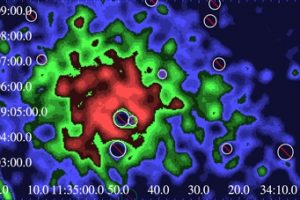The cosmological environment of radio galaxies in the Local Universe. the study: “Deciphering the Large-scale Environment of Radio Galaxies in the Local Universe. II. A Statistical Analysis of Environmental Properties” of F. Massaro (UniTo/OATo) recently appeared on ApJ

Some galaxies are more than 100 times brighter in the radio wavelengths than the other galaxies, being thus classified as “radio galaxies“. Images at high spatial resolution have shown that the radio emission in these sources arises mainly from two regions, called “radio lobes“, extended hundreds of light years and symmetric with respect to the center of the galaxy. The emission from the radio lobes has not a stellar origin, but it is due to relativistic electrons travelling nearly at speed light in magnetic fields (synchrotron emission). These peculiar properties of radio galaxies are due to a supermassive black hole (tens to hundreds million times more massive than our Sun) hosted in the center of the galaxy, which ejects jets of plasma at relativistic velocity. After traveling for thousands of light years, these jets are slowed down by the interaction with the local medium, forming the two lobes. The timescales of this phenomenon are quite short: the radio lobes last typically 1 to 100 million years, a tiny fraction of the entire life of a galaxy.
Radio galaxies are typically classified on the basis of the morphology of their radio emission into: Fanaroff and Riley Class I (FRI) and Class II (FRII) sources. Galaxies in the former class emits most of their radio emission from their center, where there is a bright jet. FRII sources are instead brighter in their edges. In these sources, in fact, the jet is fainter than in FRI sources, and most of the energy is radiated away from the edges of the radio lobes.
The international team of researchers led by F. Massaro (University of Turin and INAF – Astronomical Observatory of Turin) has compiled a catalog of radio galaxies in the Local Universe, e.g. within a redshift equal to 0.15 (the redshift is a spectroscopic measurement of the velocity at which sources move away from us, which is connected to their distances by the Hubble law), distinguishing between FRI and FRII sources according to the morphology of their radio emission. For each radio galaxy in their catalog, the authors have also measured the local density of nearby cosmological sources, by identifying sources close to each radio galaxy both in terms of distance and redshift. In this way, they have demonstrated that radio galaxies in the Local Universe typically lie in rich large-scale environments. Besides, this property depends neither on the classes of the radio galaxies nor on their redshift. The study is described in the paper: “Deciphering the Large-scale Environment of Radio Galaxies in the Local Universe. II. A Statistical Analysis of Environmental Properties“, recently appeared on The Astrophysical Journal. The astronomer I. Pillitteri (INAF – Astronomical Observatory of Palermo) is a coauthor of the study.
The image (click here to visualize the entire figure) shows an X-ray image of a FRI radio galaxy obtained from the ESA observatory XMM/Newton, showing that even a shallow X-ray observation can detect the X-ray emission from the hot gas filling the space between galaxies around the central radio galaxy.
Mario Giuseppe Guarcello ( follow mguarce)
